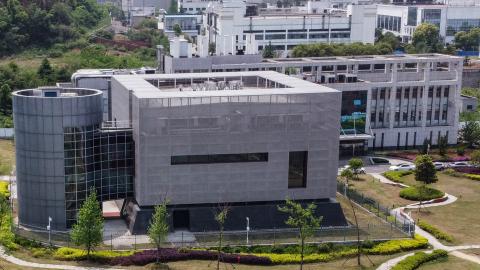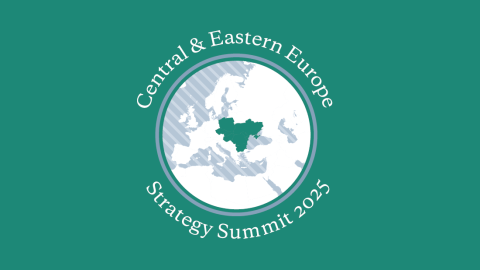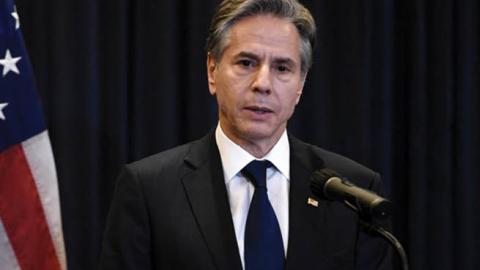The Indo-Pacific region's continued rise is a near certainty. Its stability is not.
The region is vast and wealthy, accounting for half the planet's population and two-thirds of its economic growth. But the question is not whether Asia writ large will dominate international relations this century. The question is how disruptive the contest for power within the region will be.
As the United States adapts to the global redistribution of power and technological innovation, a successful Indo-Pacific shaping strategy is imperative.
The Biden administration's new Indo-Pacific Strategy essentially hits the mark, building on America's position as a permanent Indo-Pacific power and longstanding commitment to forward military presence and open commerce. Rather than counterproductively fixate on "America First", Washington is renewing its concentration on allies and partners to ensure peace, prosperity and pluralism.
Under the guiding hand of Mr Kurt Campbell, Deputy Assistant to the President and Coordinator for Indo-Pacific Affairs, the White House's Feb 11 regional strategy provides an elegant declaration of US power and purpose. The strategy stands in sharp contrast to the joint statement issued a week earlier by President Xi Jinping and his Russian counterpart Vladimir Putin in Beijing. While the Xi-Putin communique proclaimed the arrival of a "new era", President Joe Biden and his team have crafted a more constructive, candid and concise vision for the future.
Of course, lucidity is no guarantor of a favourable balance of power. And many will ask if Washington's plan of action for the next chapter of US engagement in the world's most consequential region will be up to snuff. The strategy offers strengths but also potential shortcomings.
Strategic promise
First, the strategy anchors America in the middle of global power.
The priority placed on the region is apparent in the administration's decision to publish this regional strategy ahead of the President's National Security Strategy (NSS). Since Ronald Reagan published the first NSS in 1987, presidents have relied on that document as the capstone of US declaratory policy. President Biden's forthcoming strategy will be the 18th NSS spanning seven administrations. Pre-empting himself highlights the Indo-Pacific's promise.
Mr. Biden's Indo-Pacific Strategy also transcends the regional strategy documents customarily released by a single government department, particularly the Defence Department.
Since April 1990, in response to a congressional request, the Pentagon periodically issues East Asia strategy reports. Mr Campbell crafted the third such report when he was deputy assistant secretary of defence for East Asian and Pacific affairs during the Clinton administration. That 1995 report opened with then-Secretary of Defence Bill Perry contrasting Asia's stability then with predictions of upheaval in the wake of America's exit from Vietnam in 1975.
America's post-Vietnam retreat was short-lived. As the Indo-Pacific Strategy emphasises, US regional engagement and military presence survived the end of the Cold War, and both the Obama and Trump administrations placed the Indo-Pacific at the world's centre of gravity. What's different this time is that the US is signalling not just its pivot to the region but the region's pivot to the world. The United States, under President Biden's leadership, is committed to a "free and open Indo-Pacific that is more connected, prosperous, secure and resilient".
Second, the strategy directly addresses US-China rivalry without allowing major-power competition to define the frontiers of what matters.
The Biden administration explains why China is the main challenge to Indo-Pacific harmony. China is combining all instruments of power to pursue "a sphere of influence" and become "the world's most influential power".
Although its "coercion and aggression spans the globe", the Indo-Pacific absorbs the brunt of that assertiveness: from economic coercion of Australia and pressure on Taiwan to conflict on the India-China border and belligerence in the East China Sea and the South China Sea. On top of this, Beijing undermines human rights, international law and the freedom of navigation, "principles that have brought stability and prosperity" to the region.
The assessment of China is to the point. But instead of convulsing over the "China threat", the administration wisely focuses on creating the conditions for success. "Our objective is not to change China but to shape the strategic environment in which it operates," the strategy states. That is reminiscent of the Trump administration's 2017 strategy that sought a favourable balance of power, something the Indo-Pacific Strategy refers to as a favourable "balance of influence".
Today, US influence is designed to tackle not just the China challenge but an array of "forces that threaten to destabilise the region", including climate change, Covid-19, North Korea's expansion of illicit weapons, natural disasters, internal conflict, poor governance and resource scarcity. The strategy warns that it would be a mistake to reduce the region to "an arena of geopolitical competition"; instead, "Indo-Pacific nations are helping to define the very nature of international order".
Third, the strategy projects comprehensive American power to all corners of the Indo-Pacific region, leverages allies and partnerships, and erects barriers to conflict.
Better than in prior documents, Washington shows a commitment to holistic power. It seeks to rally economic, diplomatic, technological and military tools for countries in all sub-regions, from South Asia and North-east Asia to South-east Asia and Oceania.
"Our vital interests… require a free and open Indo-Pacific," the strategy declares. With nearly US$2 trillion (S$2.7 trillion) in annual two-way trade and almost US$1 trillion in foreign direct investment, the Biden administration explains why "the prosperity of everyday Americans is linked to the Indo-Pacific".
The US will rely on its "single greatest asymmetric strength: our network of security alliances and partnerships" to counter aggression and coercion.
The administration thinks it can preserve stability and defeat attack with forward engagement and "integrated deterrence". But it will also seek to limit dangerous competition by cleaving to the "One China policy" and working with various actors, including "rivals", to manage crises on the Korean peninsula.
Finally, the strategy leavens American optimism and enthusiasm for democratic values with pragmatic respect for autonomy, diversity and good governance.
The United States wants governments to make independent political choices free from coercion, foreign interference and disinformation. But in stressing that it favours a free press, a vibrant civil society, media literacy and fiscal transparency, the strategy settles for empowering the region's aspirations and strengthening institutions that intersect US interests and values. Similarly, while it wants to improve labour and environmental standards, the strategy leans on diplomacy to find common ground with regional states.
The strategy's touchstone is supporting partners with their demands for greater capability, not imposing America's values. While even kinder and gentler democracy promotion has a decidedly mixed record, the world is generally a better place when the US stands up for liberty and the rule of law.
In seeking a pragmatic yet principled approach to regional and global affairs, the Biden administration understands that American democracy remains a work in progress and does not enjoy the mantle of international primacy it once was presumed to hold. Still, even a realistic and intellectually coherent strategic statement such as the Indo-Pacific Strategy must confront its potential pitfalls. Let me raise five.
Potential pitfalls
First, what is the nature of the US-China rivalry, and how does the Biden administration define its "end state"?
Most of the challenges with the administration's regional strategy centre on means and ways, but the first-order question relates to ends: What is the nature of the competition with China, and where is it heading? The region wants to know.
Is it a contest over the balance of power and influence, rules of the road or the post-World War II security system? Are we in a protracted political struggle or preparing for war? Is success defined as cooperative rivalry, peaceful coexistence, convergence or subjugation? Are we shaping the environment, responding to it or being shaped by it?
The strategy wisely ducks these important if imponderable questions. But Americans and regional observers will be watching closely to determine the full implications of the China dream for those who don't subscribe to Beijing's party line.
Second, are alliances as grand as advertised?
Going it with others is much better than going it alone. Further, the Biden administration's embrace of allies and partners has long been a feature of US foreign policy.
Nevertheless, allies and partners pose liabilities as potential catalysts for major-power war, free riders and moral hazards. Even when allies and partners share interests and have complementary instruments of power, managing classic concerns over abandonment and entrapment consumes an administration's finite time and resources, often without rendering the desired strategic effect.
The lack of allies does not seem to detract from China and Russia's ability to wield power. Or maybe that is what has forced Beijing and Moscow into ever-closer strategic alignment over the past two decades. The Sino-Russo entente appears united to weaken US influence and make the world safe for autocracy and spheres of influence.
The Biden administration is undoubtedly correct about the value of teamwork among like-minded states. However, the question is whether those team members are sufficiently aligned and capable of dealing with the region's most pressing challenges.
A third potential shortcoming may be the weakest link of US regional strategy: an inadequate economic and trade policy.
The United States claims to be driving regional prosperity. A majority of elite opinion in the region would question that assertion. True, America accounts for nearly US$3 trillion of economic activity a year in the Indo-Pacific. Still, what is the future trajectory? The challenge is to play a critical role in tomorrow's finance, trade, investment and technological innovation.
Despite serious questions about China's stagnating economy, it is still seen as the region's economic engine. The Belt and Road Initiative presents deals in the tens of billions of dollars; the US counters with promises of "high-quality" infrastructure. China's state media touts cutting-edge technology developments and goals; the US is mired in minimalist industrial policy to protect supply chains and critical technology sectors. China engages regional multilateral trade pacts (joining the Regional Comprehensive Economic Partnership, requesting accession to the Comprehensive and Progressive Agreement for Trans-Pacific Partnership); Washington promises a still amorphous Indo-Pacific economic framework.
China's objective advantage as an engine of prosperity for the region may be illusory, but the Biden administration will need to do far more to demonstrate that is the case.
Fourth, can the Biden administration make the region more secure?
The problem with "integrated deterrence" as a "cornerstone" of US strategy is that the concept lacks clarity in its definition or application. The outcome of the latest Ukraine crisis, for instance, may well have a bearing on what happens to Taiwan more than attesting to the importance of cross-strait stability. At least, it's not apparent how integrated deterrence will make Taiwan less susceptible to Beijing's blanket harassment and taunting of Taipei.
Similarly, North Korea's mounting missile and nuclear arsenal may not lead to conflict. Still, it is hard to see how its advanced weapons are eliminated. Working with rivals to manage crises may offer a more credible avenue for progress than negotiation with North Korea. But that presupposes that Beijing has a genuine interest in forging cooperation with the US.
Finally, is the United States at risk of overpromising and under-delivering once again?
The strategy's 10-point action plan begins with the notion of shifting resources to the Indo-Pacific. That wasn't easy to do during the Obama administration, and the appetite for bipartisanship was arguably better than it is today.
Moreover, the resources to be driven to the Indo-Pacific are not that plentiful: Underfunded US Coast Guard forces? A "historic" US-Asean special summit? Quad countries (the United States, Japan, Australia and India) stepping up the provision of public goods such as vaccine doses and infrastructure? Each of these is a worthy endeavour that will be difficult to realise and, even then, not likely to have the desired strategic effect.
The fundamental optimism of the Indo-Pacific Strategy of 2022 thus mirrors the optimism of the Clinton administration's first East Asia report in 1995.
Past "gloomy predictions proved wrong", the earlier report claimed, because American alliances and presence in the region did not evaporate after the withdrawal from Vietnam.
But the report also issued a stark warning even in the euphoria of the unipolar moment: "Security is like oxygen: You do not notice it until you lose it. The American security presence has helped provide this 'oxygen' for East Asian development."
America remains moored to the Indo-Pacific region. It also remains determined to provide it with oxygen.
In contrast to 1995, however, the US no longer has a corner on the oxygen market. It must compete with China while seeking to deliver prosperity, security and resilience to a more influential and prosperous region.
Read in The Straits Times



















